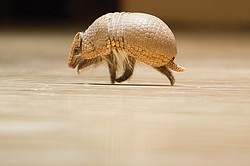Symphony of animals
Jack Hanna & Youngstown Symphony

Jack Hanna performs animal themed readings with musical accompaniment from the Youngstown Symphony at DeYor Performing Arts Center in Youngstown on October 24, 2010.
JACK HANNA
Fast facts
Hanna, considered by many as one of the country’s foremost wildlife experts, brought some of his animals for a matinee performance Sunday with the Youngstown Symphony Orchestra at Edward W. Powers Auditorium. A brief look at his background:
Raised on his father’s farm and began at age 11 assisting a local veterinarian.
Majored in political science and business at Muskingham College in New Concord, Ohio.
Got into trouble at Muskingham for keeping ducks in his dorm room and trying to smuggle a donkey on campus.
Was director of the Sanford Zoo in central Florida before becoming director of the Columbus Zoo & Aquarium.
From 1981 to 1983, hosted “Hanna’s Ark,” a show on a Columbus TV station.
Published his autobiography, “Monkey’s on the Interstate” in 1989.
Named in 1996 as one of People magazine’s 50 Most Beautiful People.
Received honorary doctorate degrees from several Ohio colleges and universities.
Source: TVguide.com
Zookeeper Jack Hanna accompanies Youngstown orchestra in exotic arrangement
By Sean Barron
YOUNGSTOWN
Even though 7-year-old Amelia Kovach lives on a farm near Sharpsville, Pa., and is accustomed to being surrounded by animals, she had no objections to adding a lynx and cheetah to her day.
“I have about 1,000 chickens, three goats …” Amelia said before breaking down in laughter.
The Sharpsville Elementary School second-grader’s laughter was largely the result of having seen Jack Hanna and his animals that were, in more ways than one, a colorful part of the Youngstown Symphony Orchestra’s performance Sunday at Edward W. Powers Auditorium.
Hanna, one of the nation’s most notable zookeepers and wildlife experts, brought animals that included a Siberian lynx, a wallaby, a small armadillo, a cheetah and a sloth, then explained some of their characteristics during the two-hour concert and educational gathering.
Preceding the animals’ stage presence was a rendition of “Carnival of the Animals,” a 14-movement piece written in 1886 by French composer Camille Saint-Saens that uses music to describe and depict animal images. Hanna also read excerpts of the Ogden Nash poem of the same name that alternated with the symphony’s brief adaptations.
Hanna is director emeritus of the Columbus Zoo and Aquarium. His animal demonstrations have been featured on “Good Morning America” and CNN’s “Larry King Live” as well as numerous times on “Late Night with David Letterman.”
Amelia’s favorite animal was the armadillo because “it was small and fast,” she added.
Abigail Halloran, 7, of Sharpsville has a puppy and is an animal lover. After Sunday’s show, she added a cheetah to her love-of-animals list.
“I like his looks,” said Abigail, who’s also Amelia’s cousin.
The two girls came with Abigail’s mother, Beth, and their uncle Frank Costello.
Costello said he appreciated Hanna’s having autographed a book the girls bought and posing with them for a picture.
Also taking a special interest in the cheetah was Sue R. Moderalli of Youngstown, an usher at Powers Auditorium and the Covelli Centre.
Moderalli recalled having met Hanna three years ago and said she sponsors two such animals at the Columbus Zoo by making donations on their behalf.
The symphony kicked off its performance with excerpts from the popular movie “The Lion King” before Hanna narrated the “Carnival of the Animals” part.
Hanna’s reading of certain animals in the Nash poem was followed by musical interpretations that sought to emulate that animal’s sounds, actions and movements. Nash’s description of a kangaroo, for example, was met with a light, melodic dialogue between two pianos that captured how the animal hops.
Afterward, Hanna and his animal handlers brought out one at a time the Siberian lynx as well as an owl, a Parma wallaby, a two-toed sloth, a three-banded armadillo, a flamingo, a black-footed penguin and a cheetah.
The Siberian lynx, which lives between 7,000 and 15,000 feet above sea level, is nearly extinct in the wild. Unlike most animals, the lynx doesn’t run on the padding of its feet because it would sink in heavy snow, Hanna noted.
Owls live on every continent except Antarctica and have highly sensitive hearing and keen sight, he explained.
Many kangaroos are able to have three babies at a time, Hanna said, adding that there are about 30 types of wallabies.
“I could take my hand and lose it in there,” Hanna said, referring to the thick fur of a sloth.
They have evolved little over thousands of years, are among the world’s slowest animals, sleep most of the day in trees and eat mainly leaves, Hanna said of sloths, many of which live in the Amazon rainforest.
Despite having poor eyesight, three-banded and other armadillos have profound hearing and can detect a worm underground, for example, Hanna pointed out, noting that the three-banded variety is endangered in South America.
Even though flamingos are typically pink or red, most are born black or gray. Their color change is largely because of what they eat, he said.
Contrary to its association with cold climates, most penguin species live in warm or temperate regions, Hanna told his audience. Of the 17 known kinds, only about five live in cold areas, Hanna noted, adding that few fear people.
The world’s fastest mammal is the cheetah, which has been clocked at 72 mph. In addition to their spots that provide camoflauge, cheetahs have dark marks under their eyes because they hunt during the heat of the day. They lie in wait before pouncing on and stunning their prey, the animal expert explained.
Hanna, who has worked with animals and given lectures and demonstrations all over the world, said one of his main goals is to educate people.
“Education is my No. 1 goal,” he said. “Without education, you can’t have conservation.”
 43
43
